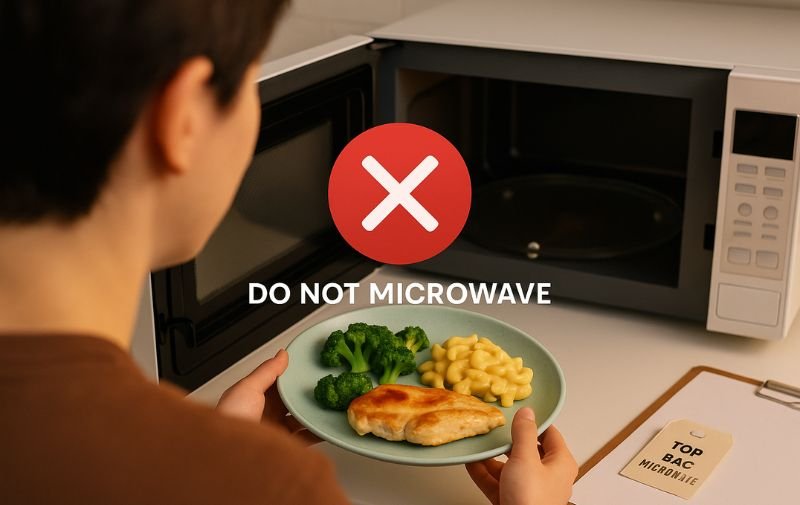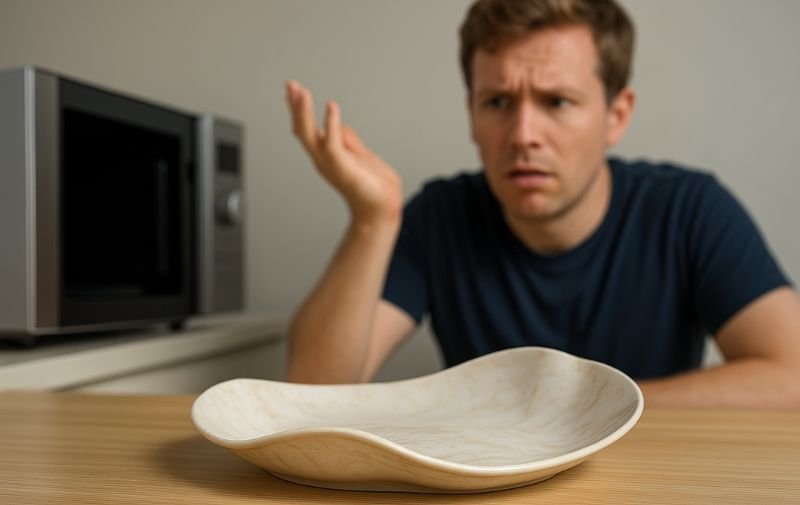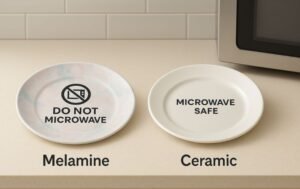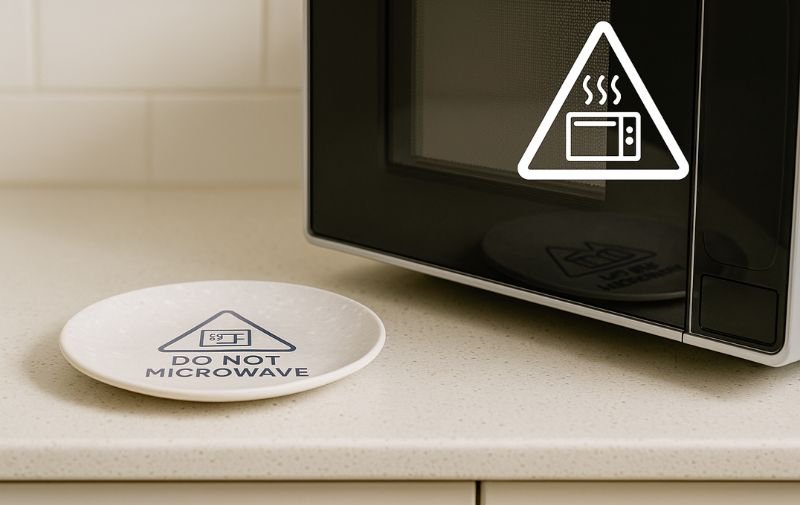You’ve got your amazing melamine plates, perfect for everyday meals and outdoor dining. But when leftovers need reheating, a crucial question arises: are melamine plates microwavable? The short, and very firm, answer is NO. This isn’t just a gentle suggestion; it’s a critical safety warning.
Let’s break down exactly why your melamine dinnerware and microwave oven should never meet.
Last Updated: May 2025 | Estimated Reading Time: 8 minutes

Are Melamine Plates Microwavable?
To be absolutely clear: No, melamine plates, bowls, cups, or any tableware made from melamine resin are NOT microwavable. This applies to all grades of melamine, including high-quality A5 food-grade melamine and bamboo fibre plates that use melamine as a binder.
Why is Microwaving Melamine Plates Strongly Discouraged?
The core issue lies in how melamine material interacts with microwave energy. It’s fundamentally different from materials like glass or microwave-safe ceramics.
How does melamine material react to microwave radiation?
Melamine Absorbs Microwaves
This is the fundamental problem. Unlike glass or most ceramics which are largely transparent to microwave radiation (allowing the microwaves to pass through and heat the food), melamine resin (even high-quality A5) absorbs microwave energy. This means the plate itself heats up significantly, often becoming much hotter than the food you’re trying to warm.
Does the way microwaves heat food affect melamine differently?
Yes. Microwaves work by causing water molecules in food to vibrate rapidly, generating heat. When the container also absorbs this energy, like melamine does, it leads to several problems:
- Inefficient Food Heating: Your food may not heat evenly or efficiently because the plate is hogging a significant amount of the microwave energy. You might end up with a scorching hot plate and lukewarm food.
- Material Degradation: The absorbed energy causes the melamine itself to overheat, pushing it beyond its safe operating limits.
What Are the Specific Dangers of Microwaving Melamine?
Microwaving melamine isn’t just about potentially ruining your plate; it poses genuine safety and health risks.
Can harmful chemicals leach from melamine into food when microwaved? {#melamine-chemical-leaching-microwave}
Yes, this is the biggest concern – chemical integrity at risk. When melamine gets too hot from microwave absorption, the resin can start to degrade. This process can cause the chemical bonds within the melamine-formaldehyde resin to break down.
- Increased Chemical Migration: This breakdown can potentially lead to an increased migration of chemicals, including formaldehyde and melamine monomers, into your food. While A5 melamine is very stable under normal serving temperatures (like holding hot soup), microwaving pushes it into an unsafe zone where leaching becomes a higher risk.
Will microwaving cause the melamine plate to warp, crack, or scorch?
Absolutely. The intense, often uneven heating from microwaves is very damaging to the plate itself:
- Warping & Blistering: The plate can lose its shape, warp, bubble up, or develop blisters.
- Cracking: It can become brittle and crack, sometimes in a dramatic fashion.
- Scorching/Burning: The plate material itself can scorch or even show burn marks.
- Reduced Lifespan: Even if it doesn’t show immediate catastrophic damage, microwaving will significantly shorten the lifespan of your melamine ware, making it more prone to breaking over time.
- Discoloration & Surface Damage: The surface can become dull, discolored, or develop a chalky, unpleasant texture.
Could the plate become dangerously hot even if the food isn’t?
Yes, and this is a significant burn hazard. Because the melamine plate absorbs so much microwave energy, it can become dangerously hot to the touch, far hotter than the food itself. Many people have been unpleasantly surprised (and painfully burned) when trying to remove a microwaved melamine plate.

Dangers of Microwaving Melamine at a Glance
| Risk Category | Specific Danger to You & Your Plate | Why It Happens Due to Microwaving |
|---|---|---|
| Health & Safety | Increased chemical leaching (e.g., formaldehyde) | Melamine resin degrades from excessive heat |
| Burn hazard from extremely hot plate | Melamine absorbs microwave energy, overheating | |
| Plate Damage | Warping, blistering, cracking, scorching | Uneven and intense heating of the material itself |
| Reduced lifespan, becomes brittle | Structural integrity compromised by heat | |
| Surface dullness, discoloration, chalky texture | Material breakdown visible on the surface | |
| Food Quality | Uneven food heating, lukewarm food & hot plate | Plate absorbs energy meant for food |
“But What If I Only Microwave It for a Very Short Time?” – Is That Okay?
This is a common question, often followed by, “I’ve done it before, and it seemed fine.” Unfortunately, even short exposure is not recommended.
- Cumulative Damage: The damage from microwaving melamine is often cumulative and not immediately obvious. A single, very short accidental exposure might not cause visible failure or make you instantly ill. However, each time it’s microwaved, the material degrades a little more.
- No Safe Threshold: There isn’t a “safe” short time for microwaving melamine. The resin begins to absorb energy and heat up immediately.
Do All Melamine Manufacturers Warn Against Microwave Use?
Yes, every responsible melamine tableware manufacturer, including Duramela, explicitly advises against microwaving their products. This isn’t just a precaution; it’s based on the fundamental material science of melamine.
- Look for Warning Labels: Reputable manufacturers will always indicate that their melamine products are not for microwave use. This is often communicated with a symbol (a microwave with a cross through it) or a written warning on the product, packaging, or care instructions.
- Absence of Warning ≠ Safety: If a melamine product has no such warning, especially if it’s unbranded or very cheap, it doesn’t mean it’s safe. It more likely means the manufacturer has cut corners on labeling and potentially on quality control.
Important Distinction: Clients often confuse “Dishwasher Safe” with “Microwave Safe.” Dishwasher safety relates to a material’s ability to withstand hot water and detergents (typically up to 70°C/160°F for short periods). Microwave safety relates to how a material interacts with microwave radiation. They are entirely different properties, and melamine is generally dishwasher safe (top rack) but never microwave safe.
How Can You Identify if a Plate (Melamine or Otherwise) is Microwave-Safe?
Always check for explicit microwave-safe indicators.
Are there standard symbols indicating microwave safety?
Yes, there are common symbols:
- Microwave Safe: Often shows wavy lines representing microwaves, sometimes with a dish underneath.
- Not Microwave Safe: Typically a microwave symbol with a prominent “X” or slash through it.
What does “microwave-safe” actually mean for dinnerware?
For a dish to be “microwave-safe,” it means:
- It does not significantly absorb microwave energy. The microwaves pass through it to heat the food.
- It does not leach harmful chemicals into food when exposed to microwaves.
- It remains stable and does not melt, warp, or crack under microwave conditions.

If Not Melamine, What Are the Best Microwave-Safe Plate Alternatives?
Thankfully, there are many excellent and safe alternatives for heating your food in the microwave:
| Material | Microwave Safety | Benefits for You | Considerations for You |
|---|---|---|---|
| Glass | Excellent | Doesn’t absorb microwaves, no chemical leaching, durable | Can get hot, can break if dropped |
| Ceramic (most) | Very Good | Generally microwave-safe, good heat retention | Check for “microwave safe” label; some glazes may contain metal |
| Stoneware | Very Good | Similar to ceramic, often very durable | Check for “microwave safe” label |
| Porcelain | Excellent | Non-porous, doesn’t absorb odors/flavors | Can be more delicate than stoneware |
| Microwave-Safe Plastics | Good (Labeled Only) | Lightweight, unbreakable | MUST be labeled “microwave-safe”; avoid old or scratched plastics |
| Always check for a “microwave-safe” label or symbol on any dish before using it in the microwave. |
What Could Happen to Your Microwave if You Use Unsafe Dishes?
While the primary risk is to the dish and your food’s safety, using highly unsuitable materials (though less common with melamine compared to, say, metal) could theoretically, in extreme cases of material arcing or melting, pose a risk to the microwave oven itself. However, the damage to the melamine plate and the chemical leaching risk are far more immediate concerns.
The Final Word: Keep Melamine Out of the Microwave
To reiterate for utmost clarity: Never put melamine plates, bowls, cups, or any melamine tableware in a microwave oven. The inherent property of the resin to absorb microwaves makes all types, including A5 grade and bamboo fiber melamine, unsuitable and unsafe for microwave use. For heating food, always choose alternatives clearly labeled as microwave-safe, such as glass, ceramic, or designated microwave-safe plastic containers. Your health and your dinnerware will thank you!
Recommended Information:
- Shop Our Durable (and Dishwasher-Safe!) Melamine Plate Collections
- FDA: Melamine in Tableware – Questions and Answers



